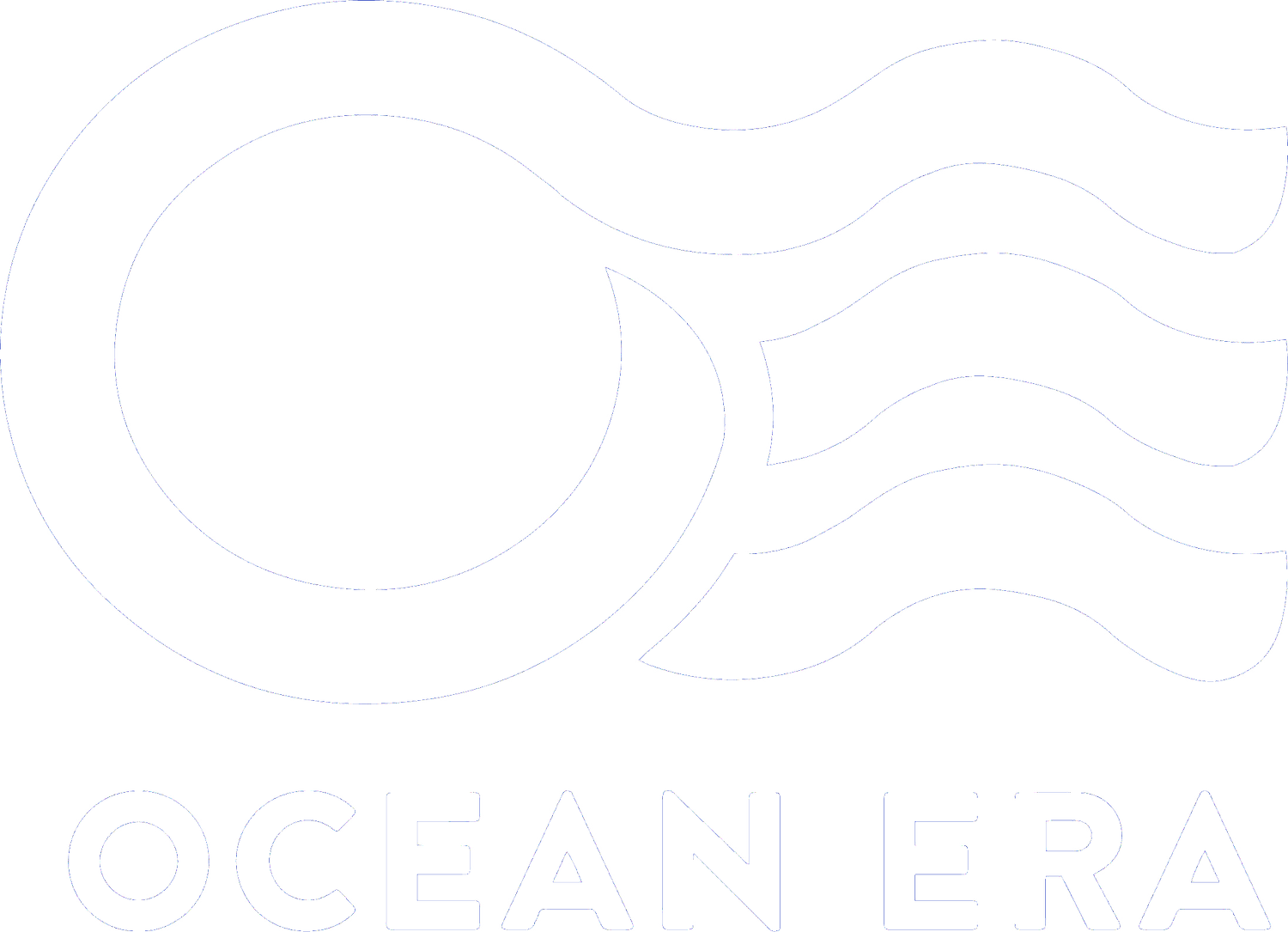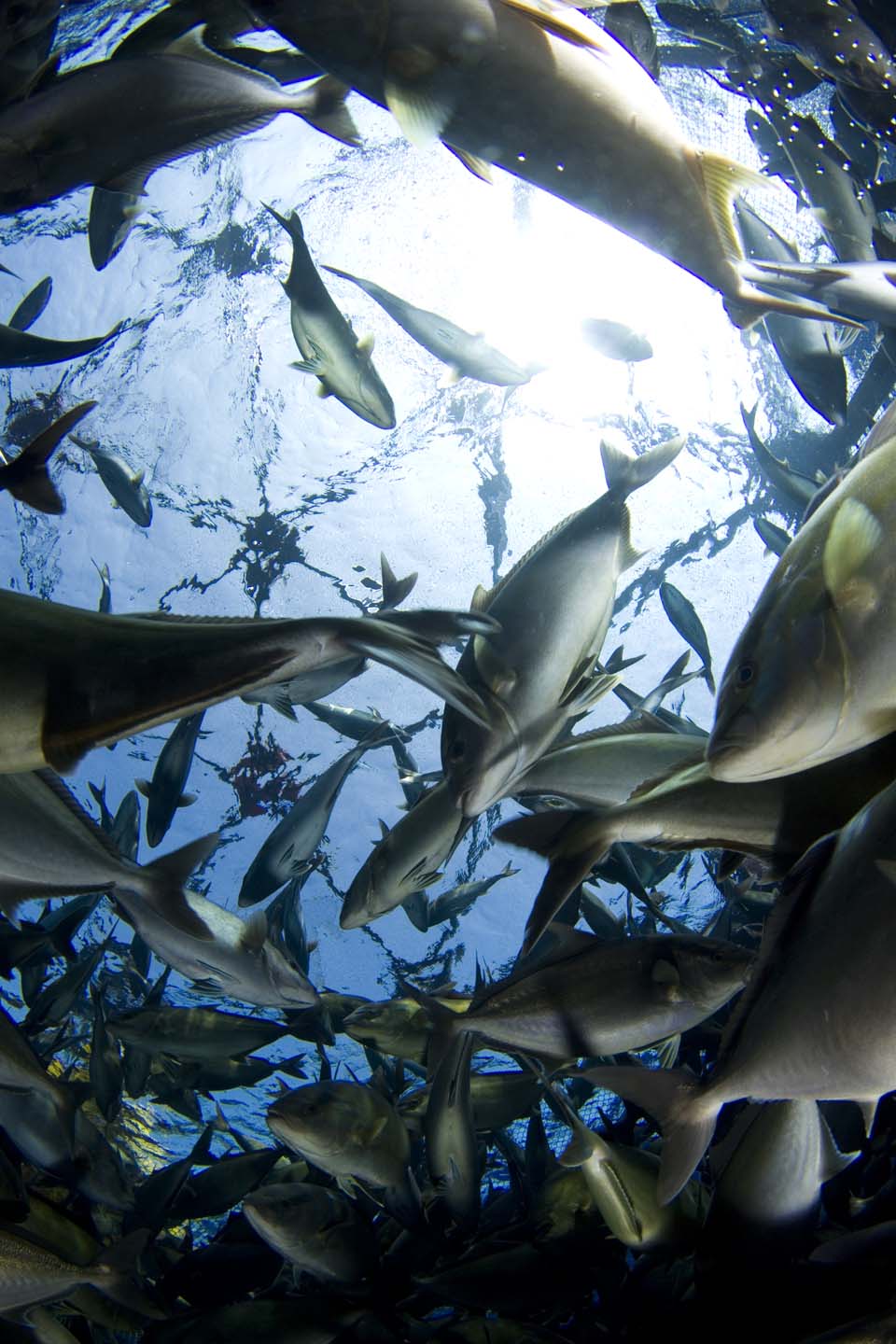Expansion of Offshore Aquaculture as a Conservation Goal
It is wonderfully refreshing to see the growing, forthright support for offshore aquaculture from marine conservationists – or at least, from the true thought-leaders among the marine conservation NGO community. We in the industry have clung to our beliefs, borne of experience, that offshore aquaculture – if done right – has immense potential to increase the production of delicious, healthful seafood, with minimal footprint on the seas. And this proposition is now increasingly supported by many of our colleagues who might previously have been more reticent, or might even have opposed our efforts.
Kampachi from the first harvest at Kona Blue Water Farms, 2005
Our earlier pioneering work with Kona Blue Water Farms had shown what was possible. Our submergible net pen array was producing up to 500 tons per year of sashimi-grade kampachi. Extensive monitoring showed no discernible impact on the surrounding water quality, or on wild fish health, or on the spectacularly rich coral-reef that lay a mere half mile inshore from the farm site. It was usually not possible to tell the difference between the water samples that were taken from control sites, up-current of the farm, with those taken from the sample sites down-current of the farm. The coral reef directly inshore is both monitored closely by the Hawaii State biologists (in Aquatic Resources Division), and also scrutinized every day by the dive tour operators – sometimes 10 or 15 boats per night - who bring legions of tourists out to the reef to consort with the manta rays.
As biologists, we understand that all ecosystems have limits to their carrying capacity, and so we have always advocated that significant scale-up of offshore aquaculture should be in deep offshore waters, in areas with brisk currents. But we also felt passionately that the further scale-up offshore had to happen; that it was an ecological imperative as well as an economic opportunity. This understanding was rooted both in our training in fisheries science, and in our recognition of future global food needs. We know that mankind has reached “peak fish” with wild stocks. Global catches are flat, at best. Even if we were to restore all wild fisheries to their optimum levels, this would still only meet about 5% of projected global protein needs (Steve Gaines, of UCSB, pers. comm.). The planet’s growing population, and the increasingly affluent middle class, are all going to demand more animal protein. From whence will it come?
For many years, most of the environmental NGOs in the marine conservation community were staunchly opposed to the idea of growing fish in the ocean. Admittedly, early aquaculture ventures struggled with limited knowledge about fish nutrition and aquatic animal health, net pen engineering and eco-system area management. But over the past three or four decades, there has been a phenomenal improvement in all areas of fish farming in the marine environment – both in the industry’s ability to produce healthy and healthful fish in an efficient manner, with minimal reliance on marine resources such as ‘forage’ fish, and in the overall management of the industry, to limit impacts to marine ecosystems. Yet many eNGOs still clung to the notion that fish farming in the ocean was somehow bad, while the farming of pigs or cows or chickens was a pastoral ideal to be celebrated and encouraged.
Well, thank goodness for science! Or perhaps, more accurately, let’s thank Conservation International and Worldfish Center for their diligent adherence to science. In 2011, these two organizations undertook a joint study – Blue Frontiers – that compared the Life Cycle Assessments of a range of animal protein production systems, and determined that – hands down, far and away – aquaculture was the least impactful of all. By comparison, they concluded, terrestrial livestock production has major impacts on greenhouse gas emissions, freshwater availability, and land use. On a finite planet, we simply cannot feed 9 billion people with hamburgers and pork sausages.
It was a powerful piece of science, and it had an immediate impact on policies. Most of the leading eNGOs disbanded their aquaculture offices (which had been purposed to largely slow down aquaculture’s growth). Most of the science-driven foundations stopped supporting anti-aquaculture advocacy, and began to quietly promote their more preferred forms of aquaculture: Integrated Multi-Trophic Aquaculture, culture of filter-feeding bivalves and freshwater fish, and Recirculating Aquaculture Systems (RAS). There was even an explicit - but only tacit - acceptance of net pen aquaculture, with the participation of a number of eNGOs in drafting of standards for responsible aquaculture.
Aside: We should give full credit where it is due, here … World Wildlife Fund (WWF - the panda-bear people) had for years – even before 2011’s Blue Frontiers - been supporting the Aquaculture Dialogue process, which provided the foundation for the most rigorous of aquaculture standards - those of the Aquaculture Stewardship Council.
However, there was very little outspoken support for helping aquaculture to grow, or for dispelling the negative stereotypes that were firmly established in consumers’ minds from the years of besmirching farmed fish. When we asked the CEO of one leading marine conservation organization if – in light of the Blue Frontiers study – he would publicly endorse responsible net pen culture, he very politely but very firmly demurred.
So yet again, let’s thank Conservation International (CI) for having the good grace, common sense and integrity to once more lead by example. Recently, in “Human Nature” the Conservation International Blog, Leah Duran outlined the “5 Myths about Farmed Seafood." And (bless them!), the dispelling of Myth No. 5 (“Farmed seafood is only grown on land and close to shore”) constituted the most forthright endorsement of the expansion of offshore aquaculture that we have yet seen from the NGO quarter. It was far more than we could have ever dared hope for! Some of it, we could not have said better ourselves: “Deeper waters and faster currents lessen pollution and disease, increase production, and reduce pressures on terrestrial and coastal habitats.” Amen!
The article extensively quoted Ben Halpern (“lead scientist for the Ocean Health Index, a tool developed by CI that tracks ocean health”). Halpern embraced “the ‘vast, untapped potential’ of deep-water aquaculture to meet global seafood needs — sustainably”. Thank you, CI … thank you!
The CI Blog also referenced a recent study, led by researchers from UC Santa Barbara, but which included scientists from the Nature Conservancy, UCLA and the National Oceanic and Atmospheric Administration. Their research, published in the peer-reviewed journal Nature Ecology and Evolution, shows the tremendous potential for scale-up of marine aquaculture. According to the study, use of the available ocean space for marine aquaculture – excluding those areas with other conflicting ocean uses or conservation concerns, and extending out to a depth of only 200 m - could produce more than 100 times the current level of consumption of seafood globally.
Further underscoring the point: the equivalent of the current harvest of all of the world’s wild-caught fisheries could be farmed in an area less than 0.015 percent of the total ocean surface; i.e. an area about the size of Lake Michigan. The challenge, the study concluded, is not ocean space, it is primarily one of policy; willpower, if you will. All that is needed is “good governance, sustainable investment and rock-solid science.”
And these essentials, we would assert, can all flow from active involvement of the conservation community, working with us to expand this industry, and ensuring that we expand in an environmentally and socially responsible manner. Now, even Seafood Watch is tweeting out, loud and proud, for aquaculture: “… farmed seafood is … the solution for our growing global demand for seafood.”
We do love to see these endorsements! But … consider, please: the conservation community is quite justly incensed with the climate-change deniers, for their unwillingness to accept the overwhelming evidence and the preponderance of opinion among scientists. So, we also quietly wonder – what will it take for the rest of the environmental community and academia to accept the science showing the need for growth in offshore aquaculture? And what will it take for them to voice this support publicly? We all need to work together to reverse consumers’ misperceptions about aquaculture, and to encourage consumers to eat more farmed seafood. The planet’s health – and consumers’ health – depend on it.
Aloha, all. And Onwards!



